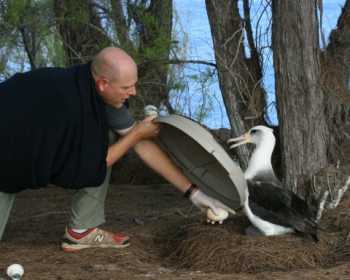Lindsay Young (Pacific Rim Conservation, Honolulu, Hawaii, USA) and colleagues have published online in the open-access journal Marine Ornithology on the results of translocating and fostering eggs of Laysan Albatrosses Phoebastria immutabilis on the Hawaiian island of Kaua’i.
The paper’s abstract follows:
“Laysan Albatrosses Phoebastria immutabilis are large seabirds that breed primarily in the Northwestern Hawaiian Islands. In the 1960s, they began colonizing new sites across the Pacific, including the US Navy’s Pacific Missile Range Facility (PMRF) on Kaua’i. Albatross were first recorded at PMRF in 1967, were breeding by 1977 and by 2012 had a colony of 84 nesting pairs. In 1988, a bird-aircraft strike hazard reduction program was begun in which adults were hazed and eggs were destroyed. In 2005, a foster parent program was initiated in which inviable eggs from Laysan Albatross pairs on Kaua’i’s North Shore were replaced with viable eggs from PMRF. From 2009 to 2012, we placed 105 eggs from PMRF in foster nests. Hatching success of foster eggs (39%) was low because most foster eggs (71%) were placed with female-female pairs, which are known to have low hatching success compared with male-female pairs (32% vs. 63%). Fledging success of foster nests (93%) was high, but overall reproductive success of foster nests (36%) was lower than average for this species because of the low hatching rate. This project contributed to the conservation of Laysan Albatrosses by producing 37 additional young for the Kaua’i population and provided valuable insights into incubation, breeding performance and fostering methods. Additional foster pairs should be sought, and sites on other islands should be identified where excess eggs from PMRF could be used to create new colonies by hand-rearing chicks.”

A Laysan Albatross receives its fostered egg, photograph by Lindsay Young
Reference:
Young, L.C., Vanderwerf, E.A., Granholm, C., Osterlund, H., Steutermann, K. & Savre, T. 2014. Breeding performance of Laysan Albatrosses Phoebastria immutabilis in a foster parent program. Marine Ornithology 42: 99-103.
John Cooper, ACAP Information Officer, 11 October 2014

 English
English  Français
Français  Español
Español